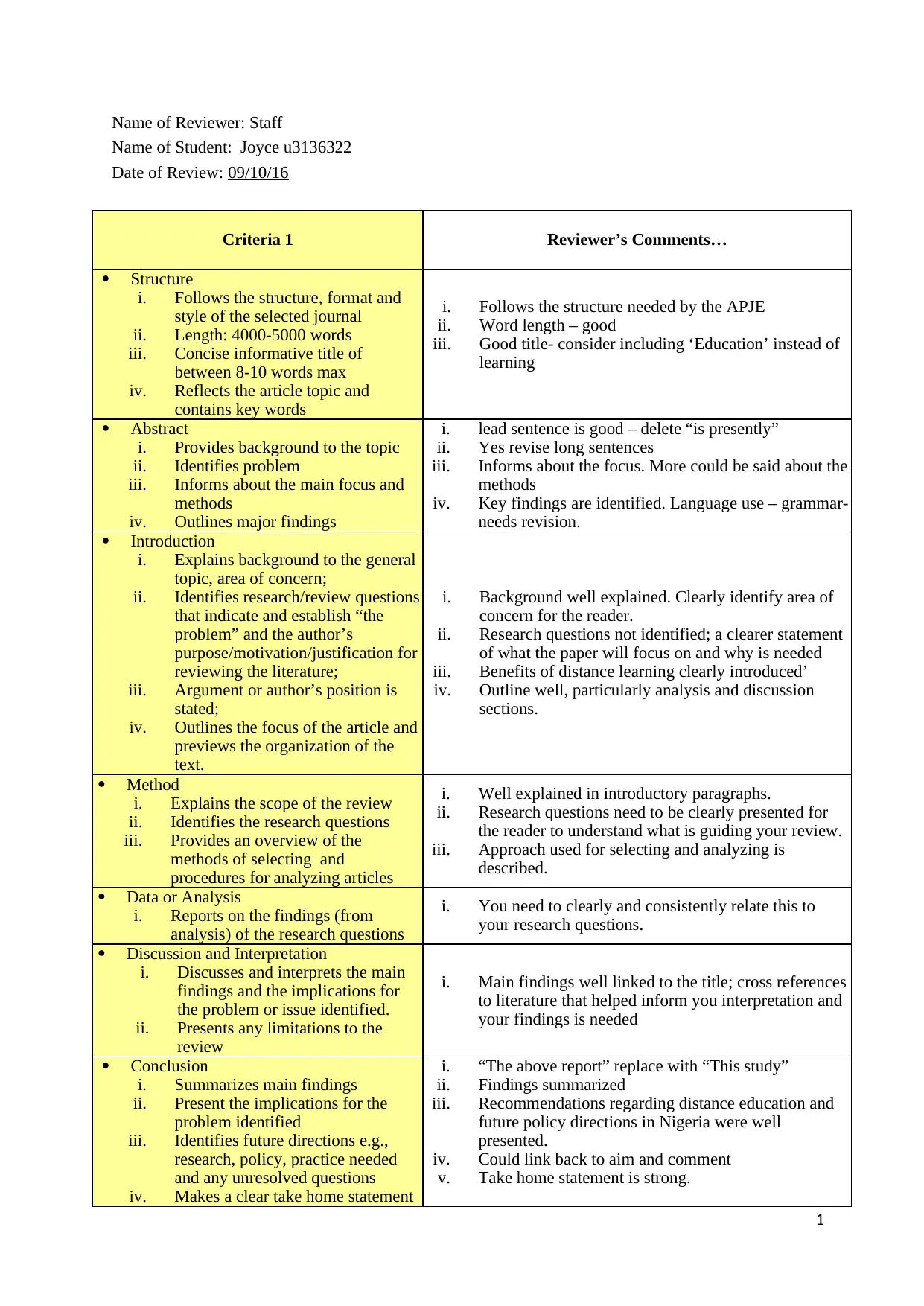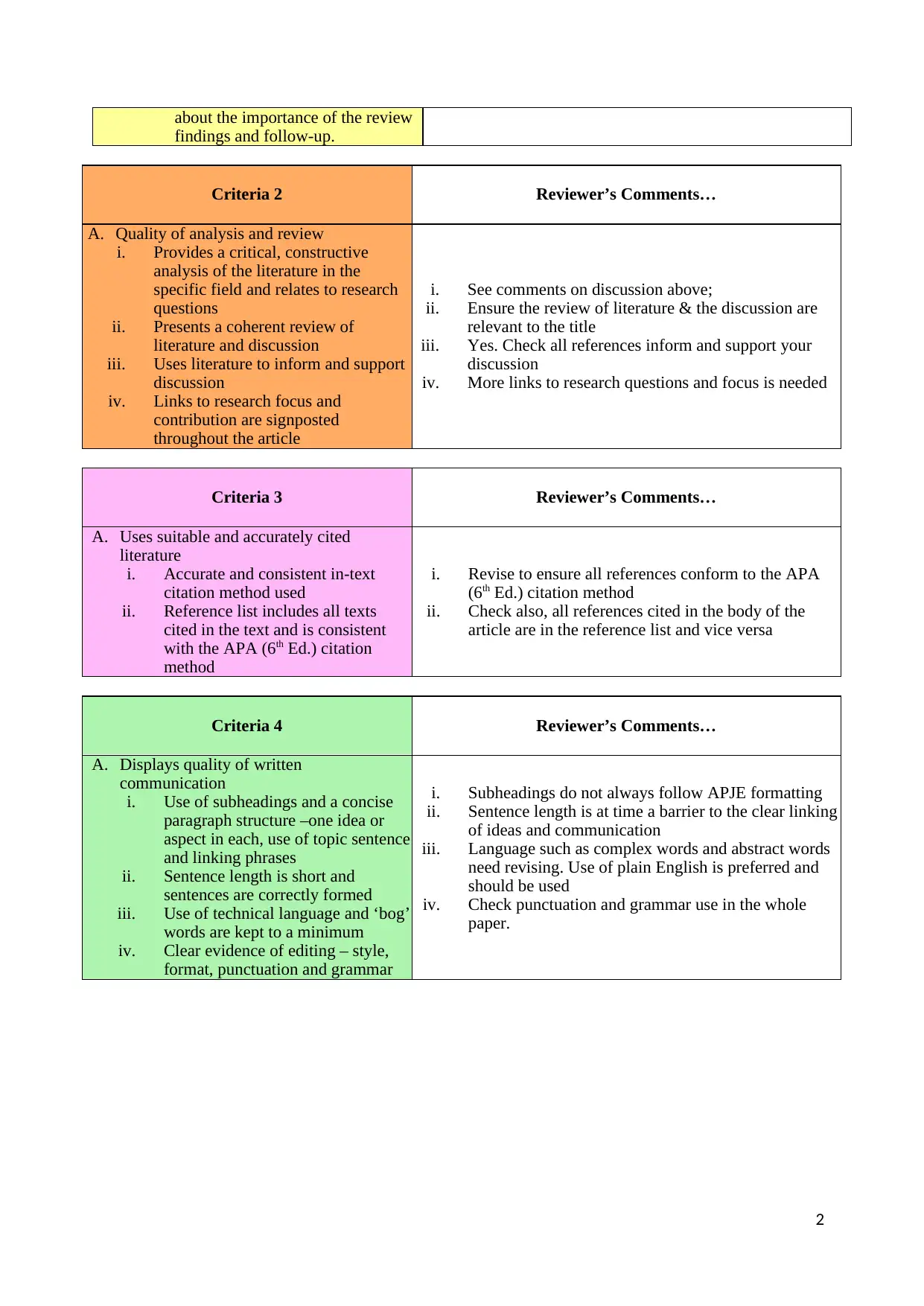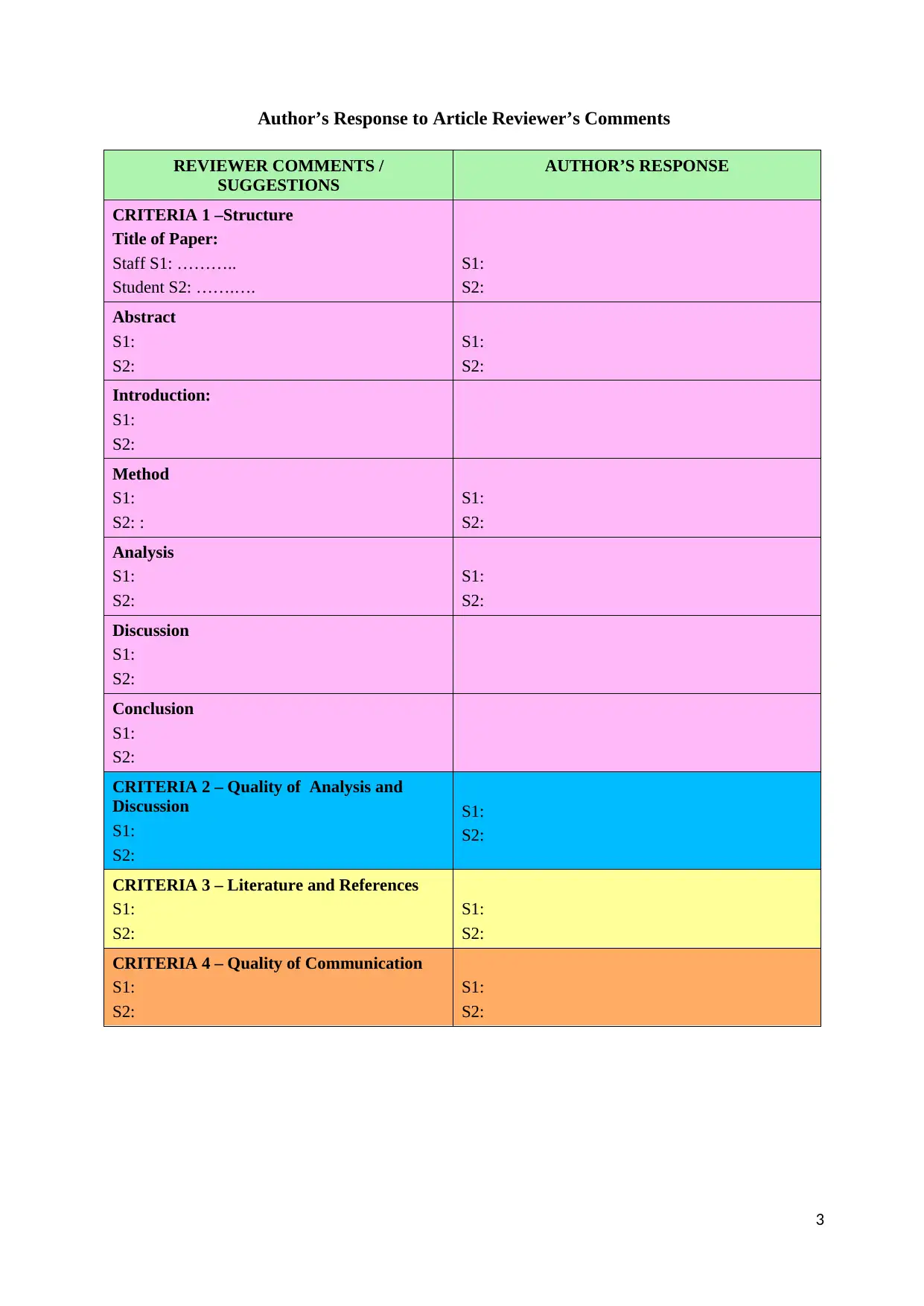Detailed Report: Analysis of Reviewer Comments and Student's Responses
VerifiedAdded on 2019/10/18
|3
|876
|211
Report
AI Summary
This document presents an analysis of reviewer comments on a student's assignment, along with the student's responses to the feedback. The report is structured based on the criteria used for evaluation, including structure, quality of analysis and review, literature and references, and quality of communication. The reviewer provides detailed feedback on various aspects of the assignment, such as the title, abstract, introduction, method, analysis, discussion, and conclusion. The comments address issues like clarity, structure, language use, and adherence to the required format. The student's responses to these comments are also included, indicating how the student plans to address the feedback and improve the assignment. The report highlights the importance of clear communication, proper citation, and a well-structured approach to academic writing.

Name of Reviewer: Staff
Name of Student: Joyce u3136322
Date of Review: 09/10/16
Criteria 1 Reviewer’s Comments…
Structure
i. Follows the structure, format and
style of the selected journal
ii. Length: 4000-5000 words
iii. Concise informative title of
between 8-10 words max
iv. Reflects the article topic and
contains key words
i. Follows the structure needed by the APJE
ii. Word length – good
iii. Good title- consider including ‘Education’ instead of
learning
Abstract
i. Provides background to the topic
ii. Identifies problem
iii. Informs about the main focus and
methods
iv. Outlines major findings
i. lead sentence is good – delete “is presently”
ii. Yes revise long sentences
iii. Informs about the focus. More could be said about the
methods
iv. Key findings are identified. Language use – grammar-
needs revision.
Introduction
i. Explains background to the general
topic, area of concern;
ii. Identifies research/review questions
that indicate and establish “the
problem” and the author’s
purpose/motivation/justification for
reviewing the literature;
iii. Argument or author’s position is
stated;
iv. Outlines the focus of the article and
previews the organization of the
text.
i. Background well explained. Clearly identify area of
concern for the reader.
ii. Research questions not identified; a clearer statement
of what the paper will focus on and why is needed
iii. Benefits of distance learning clearly introduced’
iv. Outline well, particularly analysis and discussion
sections.
Method
i. Explains the scope of the review
ii. Identifies the research questions
iii. Provides an overview of the
methods of selecting and
procedures for analyzing articles
i. Well explained in introductory paragraphs.
ii. Research questions need to be clearly presented for
the reader to understand what is guiding your review.
iii. Approach used for selecting and analyzing is
described.
Data or Analysis
i. Reports on the findings (from
analysis) of the research questions
i. You need to clearly and consistently relate this to
your research questions.
Discussion and Interpretation
i. Discusses and interprets the main
findings and the implications for
the problem or issue identified.
ii. Presents any limitations to the
review
i. Main findings well linked to the title; cross references
to literature that helped inform you interpretation and
your findings is needed
Conclusion
i. Summarizes main findings
ii. Present the implications for the
problem identified
iii. Identifies future directions e.g.,
research, policy, practice needed
and any unresolved questions
iv. Makes a clear take home statement
i. “The above report” replace with “This study”
ii. Findings summarized
iii. Recommendations regarding distance education and
future policy directions in Nigeria were well
presented.
iv. Could link back to aim and comment
v. Take home statement is strong.
1
Name of Student: Joyce u3136322
Date of Review: 09/10/16
Criteria 1 Reviewer’s Comments…
Structure
i. Follows the structure, format and
style of the selected journal
ii. Length: 4000-5000 words
iii. Concise informative title of
between 8-10 words max
iv. Reflects the article topic and
contains key words
i. Follows the structure needed by the APJE
ii. Word length – good
iii. Good title- consider including ‘Education’ instead of
learning
Abstract
i. Provides background to the topic
ii. Identifies problem
iii. Informs about the main focus and
methods
iv. Outlines major findings
i. lead sentence is good – delete “is presently”
ii. Yes revise long sentences
iii. Informs about the focus. More could be said about the
methods
iv. Key findings are identified. Language use – grammar-
needs revision.
Introduction
i. Explains background to the general
topic, area of concern;
ii. Identifies research/review questions
that indicate and establish “the
problem” and the author’s
purpose/motivation/justification for
reviewing the literature;
iii. Argument or author’s position is
stated;
iv. Outlines the focus of the article and
previews the organization of the
text.
i. Background well explained. Clearly identify area of
concern for the reader.
ii. Research questions not identified; a clearer statement
of what the paper will focus on and why is needed
iii. Benefits of distance learning clearly introduced’
iv. Outline well, particularly analysis and discussion
sections.
Method
i. Explains the scope of the review
ii. Identifies the research questions
iii. Provides an overview of the
methods of selecting and
procedures for analyzing articles
i. Well explained in introductory paragraphs.
ii. Research questions need to be clearly presented for
the reader to understand what is guiding your review.
iii. Approach used for selecting and analyzing is
described.
Data or Analysis
i. Reports on the findings (from
analysis) of the research questions
i. You need to clearly and consistently relate this to
your research questions.
Discussion and Interpretation
i. Discusses and interprets the main
findings and the implications for
the problem or issue identified.
ii. Presents any limitations to the
review
i. Main findings well linked to the title; cross references
to literature that helped inform you interpretation and
your findings is needed
Conclusion
i. Summarizes main findings
ii. Present the implications for the
problem identified
iii. Identifies future directions e.g.,
research, policy, practice needed
and any unresolved questions
iv. Makes a clear take home statement
i. “The above report” replace with “This study”
ii. Findings summarized
iii. Recommendations regarding distance education and
future policy directions in Nigeria were well
presented.
iv. Could link back to aim and comment
v. Take home statement is strong.
1
Paraphrase This Document
Need a fresh take? Get an instant paraphrase of this document with our AI Paraphraser

about the importance of the review
findings and follow-up.
Criteria 2 Reviewer’s Comments…
A. Quality of analysis and review
i. Provides a critical, constructive
analysis of the literature in the
specific field and relates to research
questions
ii. Presents a coherent review of
literature and discussion
iii. Uses literature to inform and support
discussion
iv. Links to research focus and
contribution are signposted
throughout the article
i. See comments on discussion above;
ii. Ensure the review of literature & the discussion are
relevant to the title
iii. Yes. Check all references inform and support your
discussion
iv. More links to research questions and focus is needed
Criteria 3 Reviewer’s Comments…
A. Uses suitable and accurately cited
literature
i. Accurate and consistent in-text
citation method used
ii. Reference list includes all texts
cited in the text and is consistent
with the APA (6th Ed.) citation
method
i. Revise to ensure all references conform to the APA
(6th Ed.) citation method
ii. Check also, all references cited in the body of the
article are in the reference list and vice versa
Criteria 4 Reviewer’s Comments…
A. Displays quality of written
communication
i. Use of subheadings and a concise
paragraph structure –one idea or
aspect in each, use of topic sentence
and linking phrases
ii. Sentence length is short and
sentences are correctly formed
iii. Use of technical language and ‘bog’
words are kept to a minimum
iv. Clear evidence of editing – style,
format, punctuation and grammar
i. Subheadings do not always follow APJE formatting
ii. Sentence length is at time a barrier to the clear linking
of ideas and communication
iii. Language such as complex words and abstract words
need revising. Use of plain English is preferred and
should be used
iv. Check punctuation and grammar use in the whole
paper.
2
findings and follow-up.
Criteria 2 Reviewer’s Comments…
A. Quality of analysis and review
i. Provides a critical, constructive
analysis of the literature in the
specific field and relates to research
questions
ii. Presents a coherent review of
literature and discussion
iii. Uses literature to inform and support
discussion
iv. Links to research focus and
contribution are signposted
throughout the article
i. See comments on discussion above;
ii. Ensure the review of literature & the discussion are
relevant to the title
iii. Yes. Check all references inform and support your
discussion
iv. More links to research questions and focus is needed
Criteria 3 Reviewer’s Comments…
A. Uses suitable and accurately cited
literature
i. Accurate and consistent in-text
citation method used
ii. Reference list includes all texts
cited in the text and is consistent
with the APA (6th Ed.) citation
method
i. Revise to ensure all references conform to the APA
(6th Ed.) citation method
ii. Check also, all references cited in the body of the
article are in the reference list and vice versa
Criteria 4 Reviewer’s Comments…
A. Displays quality of written
communication
i. Use of subheadings and a concise
paragraph structure –one idea or
aspect in each, use of topic sentence
and linking phrases
ii. Sentence length is short and
sentences are correctly formed
iii. Use of technical language and ‘bog’
words are kept to a minimum
iv. Clear evidence of editing – style,
format, punctuation and grammar
i. Subheadings do not always follow APJE formatting
ii. Sentence length is at time a barrier to the clear linking
of ideas and communication
iii. Language such as complex words and abstract words
need revising. Use of plain English is preferred and
should be used
iv. Check punctuation and grammar use in the whole
paper.
2

Author’s Response to Article Reviewer’s Comments
REVIEWER COMMENTS /
SUGGESTIONS
AUTHOR’S RESPONSE
CRITERIA 1 –Structure
Title of Paper:
Staff S1: ………..
Student S2: …….….
S1:
S2:
Abstract
S1:
S2:
S1:
S2:
Introduction:
S1:
S2:
Method
S1:
S2: :
S1:
S2:
Analysis
S1:
S2:
S1:
S2:
Discussion
S1:
S2:
Conclusion
S1:
S2:
CRITERIA 2 – Quality of Analysis and
Discussion
S1:
S2:
S1:
S2:
CRITERIA 3 – Literature and References
S1:
S2:
S1:
S2:
CRITERIA 4 – Quality of Communication
S1:
S2:
S1:
S2:
3
REVIEWER COMMENTS /
SUGGESTIONS
AUTHOR’S RESPONSE
CRITERIA 1 –Structure
Title of Paper:
Staff S1: ………..
Student S2: …….….
S1:
S2:
Abstract
S1:
S2:
S1:
S2:
Introduction:
S1:
S2:
Method
S1:
S2: :
S1:
S2:
Analysis
S1:
S2:
S1:
S2:
Discussion
S1:
S2:
Conclusion
S1:
S2:
CRITERIA 2 – Quality of Analysis and
Discussion
S1:
S2:
S1:
S2:
CRITERIA 3 – Literature and References
S1:
S2:
S1:
S2:
CRITERIA 4 – Quality of Communication
S1:
S2:
S1:
S2:
3
⊘ This is a preview!⊘
Do you want full access?
Subscribe today to unlock all pages.

Trusted by 1+ million students worldwide
1 out of 3
Related Documents
Your All-in-One AI-Powered Toolkit for Academic Success.
+13062052269
info@desklib.com
Available 24*7 on WhatsApp / Email
![[object Object]](/_next/static/media/star-bottom.7253800d.svg)
Unlock your academic potential
Copyright © 2020–2025 A2Z Services. All Rights Reserved. Developed and managed by ZUCOL.





